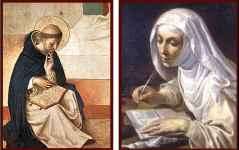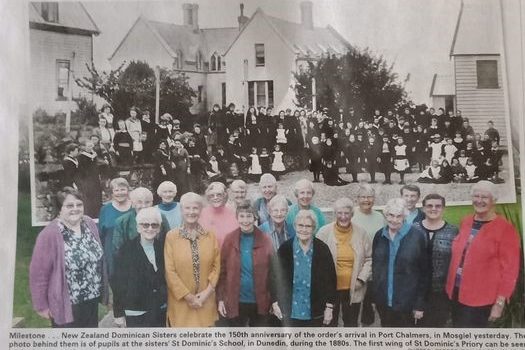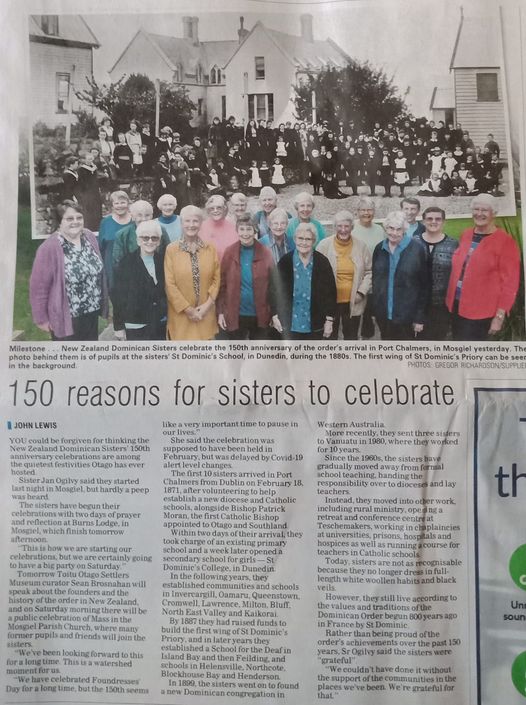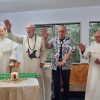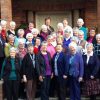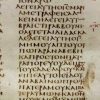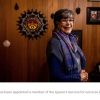We give thanks for our Dominican Sisters and their ministry. We give thanks for their willingness to share this homily which was given at St Mary’s Church, Mosgiel on Saturday 27 March, 2021 by Sandra Winton OP.
‘He stood up to read, and the scroll of the prophet Isaiah was given to him. He unrolled the scroll and found the place.…’
Jesus is sitting among the congregation in the synagogue of Nazareth. He rises to his feet and the synagogue attendant carries over to him the double roll of the book of the prophecy of Isaiah. It is laid flat in front of him and he takes the two handles and rolls it, probably from left to right, until he finds the place that he is seeking, a text hundreds of years old. He reads the words of the ancient prophet, words that speak of an anointing by the Spirit of God and a being sent by that same Spirit, to the poor, the captives, the blind, the oppressed. He reads of ‘the year of God’s favour’. Then he rolls up the scroll and hands it back to the attendant. He does not proceed to offer an explanation of these sacred words from history. The ancient text has spoken to him and now it is laid aside. There is only himself. ‘Today this scripture has been fulfilled in your hearing.’ Jesus is not revealing his plan, his programme, his targets. Rather he lays open his own self, the deepest calling of his heart, the centre of who he is and what he lives for – the mission to bring the love and compassion of God, to bring God’s justice to this earth and it’s most needy people. This is what drives him. This is his meaning. This is his joy. He himself is the text.
And we today are standing before a one-hundred and fifty-year-old scroll, unrolling it to find the text that will speak to us today. Do we start right at the beginning, the life of Jesus? The life of Dominic? The two elderly sisters, Julia and Mary, who sailed in an open boat from Spain in 1686 to re-found Dominican women’s religious life in Ireland? Or do we find our text with those ten Irish women who sailed from the convent of Sion Hill in Dublin arriving at Port Chalmers on 18 February 1871? Sister Agnes Rooney, from Country Meath, aged 60, Sister Francis Sullivan, of Dublin, aged 45, Sister Vincent Whitty, also of Dublin, aged 39, Sister Gabriel Gill, of Rathmines, Dublin, aged 34, Sister Lucy Tracy, another Dublin woman, aged 44, Sister Catherine Hughes, aged 40, Sister Gertrude Dooley, aged 33, Sister Di Ricci Kirby, from Country Limerick, aged 33, Sister Peter Jordan, from Wicklow, two weeks short of her 22nd birthday, Sister Mary Bertrand McLoughlin, from County Roscommon, who turned 20 on the voyage.
Reading their letters from the time, we can only be struck by the force of their resolution, their determination to overcome all obstacles, their gaiety, humour and optimism. They had come all the way from the other side of the world, with their bishop. Like Jesus in the synagogue at Nazareth, they felt acutely aware that they had a mission from God. They were sustained by it and driven by it. They were filled with its light. They were not coming to preach to the heathens but to consolidate a catholic community, among the muddy streets and protestant church bells of Dunedin. They were colourful individuals and they were a close-knit group. In the kitchen, the classroom, against the noise of pianos, harps, violins, in the endless fundraising, in the chapel and the laughter of the recreation room, they were a team.
Today I do not intend to list their achievements, the schools and convents they founded, the church they helped build, the economic miracles they wrought from fairs and raffles working with the catholic people who gathered around them and worked alongside them from the
very start. We have Sister Augustine’s books and Suzannah Grant’s loving history for that. Rather I would like us to think of what was inside them, their anointing, their mission, the light that shone in their lives. It was a deep faith and openness that was nurtured first of all within the community of the Sion Hill convent and individually by the personal prayer and silent awareness of God that created this space in which the Spirit of God could move. With faith-filled courage and amazing financial boldness, they reproduced in Dunedin and the larger towns of the colony the solid convents of home. Then, with an even more adventurous spirit, they departed from the way of life they had known in Ireland and moved out in threes and fours to set up small houses in the remote and rough parts of the diocese – first Queenstown, then Milton, Lawrence, Cromwell and Bluff, and, further north, Helensville. They ventured into teaching deaf children. They even went to West Australia. The sisters themselves, used to the stability of large, prosperous Irish convents, joked about their ‘mania for dispersal’. They were indeed scattering the seed.
We turn the scroll again winding the rods from hand to hand. We come to the 1960’s, Vatican II and the huge shifts in the church and religious life that followed the changes to society in this period of history. If the early sisters joked about the speed of the new foundations in the 19th century, we can only imagine what they would have thought about the very different kind of ‘dispersal’ that followed Vatican II. Here it was a ‘dispersal’ that involved a profound change in the way of life of the sisters themselves and in their mission. As the world of pioneering New Zealand was different from the world of Dublin, the world of the later 20th century was not that of earlier times. The sisters let go of much that was dear and precious to them, entrusting the schools to lay teachers and moving out themselves into new ventures, rural mission, the Teschemakers Conference centre, a mission in Vanuatu, new areas of teaching and pastoral work, fresh approaches to spirituality, the ecological project of Korimako in Invercargill. They brought to New Zealand, and made available speakers and teachers who opened new ways of thinking about Christian and catholic life, about the place of women, the place of Maori and pakeha in Aotearoa, the imperatives of response to climate change and the degradation of the planet. They embraced and fostered a new faith and a new spirituality.
I can only say that the Dominican Sisters of the 20th and 21st centuries were and are as joyful, hopeful, and courageous and as were the first ten women. The fire for mission, the openness to the work of the Spirit in God’s church and country are still alight. And as it was right from the beginning, we walk alongside other women and men, not as your teachers and guides but as companions on the journey.
And now we face other challenges. We all do. We are older. We are few in number. The scroll is rolled very far through the text. There is more that has been read than is still to come. But is it not true that, as we face a time we have never lived before, we are forced to acknowledge that it is not buildings and institutions that are the essence of Dominican life? It is who we are.
‘Today this scripture has been fulfilled in your hearing’. For us sisters, and for all of you who have been warmed by the Dominican spirit and by your friendship with us, we ourselves are the scripture for this time. It is our lives that speak.
And we are called together, in this new time, to be part of building a church that has a new face, a face of compassion for the most desperate and excluded – refugees, migrants, people who are trafficked, people who have been abused, especially within the church, people of different sexuality. We are to be a church with dirty hands as Pope Francis describes, and at the same time a church that is deeply contemplative and committed to the love of our one precious earth and all who inhabit her.
The essence, to use a Dominican word, lies in the truth of who we are. It lies in the deep contemplative centre from which everything flows. It binds us together in friendship which strengthens and encourages us through the darkest times. It tethers us to the sacred memory of God’s unfailing love. For all this let us give thanks, and thanks and thanks.
You may also like to read this article from the Otago Daily Times:
